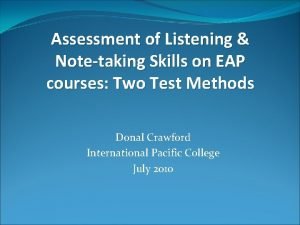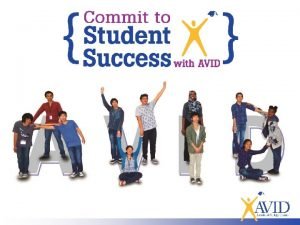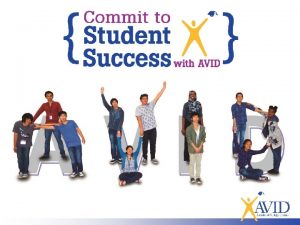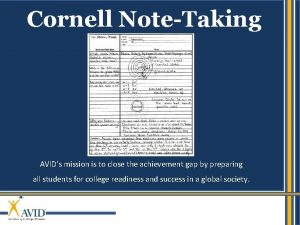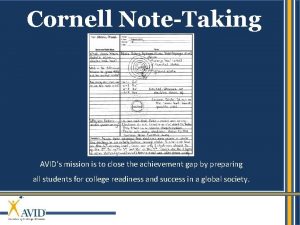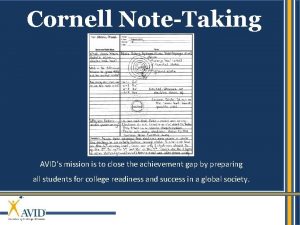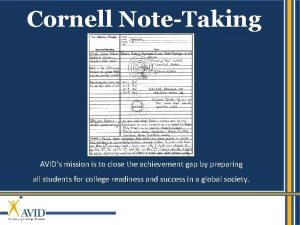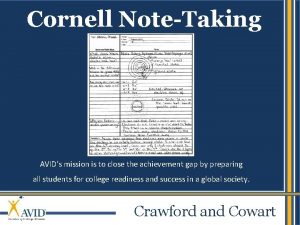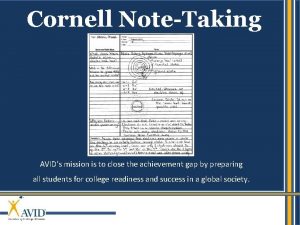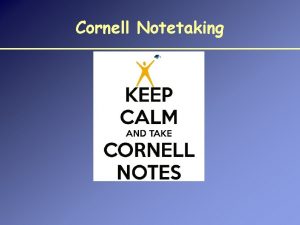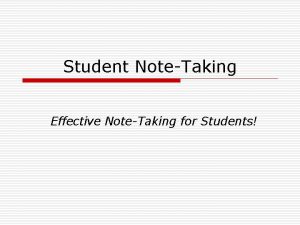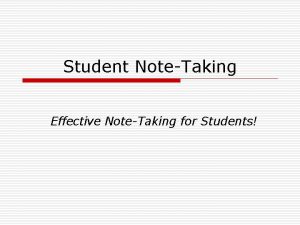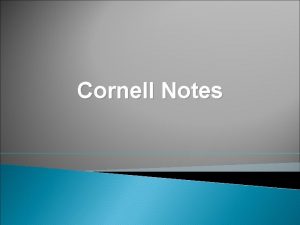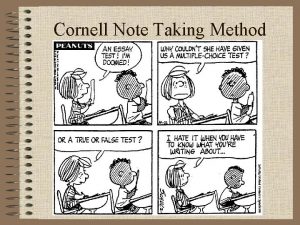Cornell NoteTaking AVIDs mission is to close the

























- Slides: 25

Cornell Note-Taking AVID’s mission is to close the achievement gap by preparing all students for college readiness and success in a global society. Classroom Teacher

Cornell Notetaking Why should you take notes? • To minimize your “rate of forgetting” þ Dr. Walter Pauk, Cornell University Reading Center þ Don’t take notes = Forget 60 % in 14 days þ Take some notes = Remember 60 % þ Take organized notes and do something with them= Remember 90 -100% indefinitely! The More the Better! 2

Cornell Notetaking • Dr. Pauk created the Cornell Notetaking System, which is used at Stanford, UCLA’s School of Engineering, most Law Schools, and of course, at Cornell University • The Cornell System requires the student to review notes and think critically after learning has taken place Date Topic Web, Picture Draw ? ? ’s Summarize 3

Cornell Notetaking When should you take notes? • Notes are a record of your learning, so take them when: þ þ You listen to a lecture You read a text You watch a film You work in a group on an activity þ You need to recall information about what happened to you in a class, meeting, or activity--which means always! 4

Cornell Notetaking What do you notice that is different about Cornell Notes? • They are divided into two parts: questions and notes • There is a reflection at the end • There is room for a topic • They are labeled with name, date, class, period or other information 5

Cornell Notetaking What types of questions should I place on the left side? • Questions which are answered in the notes on the right • Questions you still need the answer to--ask a friend or the teacher after class • Questions the teacher might ask on a test • Higher level thinking questions 6

Cornell Notetaking What else could I place on the left side? • Key terms, vocabulary words, or dates • Diagrams or figures • Reference pages in a text • Steps in a solution process • Notes to myself about actions I need to take 7

Cornell Notetaking What are the steps to taking Cornell Notes? • Set up your page 3 Draw your margins 3 Label clearly • Take notes 3 Use your best strategies • Actively listen, analyze, ask questions • Review, revise, reflect 3 Look over notes and highlight, edit, or add info 3 Write your questions and reflection 8

Some Basics • Advantages – Method for mastering information – Efficient – Sequential • Materials – Cornell note paper – Basic loose-leaf paper 9

C-Note Paper Samples 10

Let’s Practice… 11

Heading… Learning to Take Cornell Notes Chivas Spivey AVID/ Per. August 1, 2013 going culture? How does using the Cornell Note-taking process promote a college 12

During the Lecture During Lecture Write In This Section Only 13

Why Take Cornell Notes? • Help you work on assignments and study for tests outside of class • Stimulates Critical Thinking skills • Helps organize and process information • Help you recall information and use your notes multiple times 14

Topic Essential Questions, Subtitles, Headings, Etc. First & Last Name Class Title Period Date Class Notes 2 1/2” 3 to 4 sentence summary across the bottom of the last page of the day’s notes, which answers the Essential Question 15

Before the Lecture Fill in Heading 16

When there is no Essential Questions Standard/Objective (ELA) 3. 6 -Identify significant literary devices (e. g. , metaphor, symbolism, dialect, irony) that define a writer’s style. Essential Question How do literary devices such as metaphor, symbolism, dialect, and irony define the writer’s style? Standard/Objective (Math) Alg. 9. 0 - Students use substitution to solve a system of two linear equations in two variables algebraically. Essential Question How is a system of two linear equations solved by substitution? Standard/Objective (SS) 10. 5. 2 - Understand the role of Appeasement, nonintervention (isolationism), and the domestic distractions in Europe and the United States prior to the outbreak of World War II. Essential Question Why is Appeasement a contributing factor to the start of World War II? Topic (Science) Diffusion and Osmosis Essential Question • What is the process of diffusion and osmosis in a membrane system? 17

During the Lecture • • From “lecture”, text, video, projects, etc. Paraphrasing Skip lines between ideas Abbreviate Use phrases Use bullets/lists Recognize cues from teachers Use outline style, diagrams, pictures, graphs 18

After the Lesson… • Highlight important information • Cross out non-essential information • Star (*) any information that might show up on a test/quiz. 19

After the Lesson… Compare your notes with a partner! 20

Generate Good Study Questions What type of • Your questions should reflect: question should I – Information on the right write? side Phrase the Question on the left – Questions that help you so that it helps you recall study the information on the right – Info that might appear on a test – Info you don’t understand – Gaps in your notes 21

At home that night… • Look over that page of notes (1 -3 mins. ) • Write a 3 or 4 sentence summary • Identify the most important pieces of information. • Answer the Essential Question and your questions on the left side in that summary. 22

Using your notes to Study Cover the notes on the right Rework/Answer questions on the left 23

Let’s Focus on your Notes • Look over your notes – Underline/highlight important information – Cross out unnecessary information • Meet with your Northwest Partner – Fill in missed information – Generate two good study question in the left column 24

Tonight’s homework • Insure you have 2 good study questions on the left • Set a timer for 3 minutes (or watch the clock), and do a Quickwrite summary answering: – How are taking Cornell Notes different from how I have taken Notes in the past? • Take Cornell Notes in at least 2 academic classes 25
 Avids mission
Avids mission What is avids mission
What is avids mission What is avids mission
What is avids mission Listening and notetaking skills
Listening and notetaking skills Cái miệng xinh xinh thế chỉ nói điều hay thôi
Cái miệng xinh xinh thế chỉ nói điều hay thôi Hình ảnh bộ gõ cơ thể búng tay
Hình ảnh bộ gõ cơ thể búng tay Mật thư tọa độ 5x5
Mật thư tọa độ 5x5 Từ ngữ thể hiện lòng nhân hậu
Từ ngữ thể hiện lòng nhân hậu Tư thế ngồi viết
Tư thế ngồi viết Thẻ vin
Thẻ vin Thế nào là giọng cùng tên?
Thế nào là giọng cùng tên? Gấu đi như thế nào
Gấu đi như thế nào Thơ thất ngôn tứ tuyệt đường luật
Thơ thất ngôn tứ tuyệt đường luật Hổ đẻ mỗi lứa mấy con
Hổ đẻ mỗi lứa mấy con Thế nào là hệ số cao nhất
Thế nào là hệ số cao nhất Diễn thế sinh thái là
Diễn thế sinh thái là Vẽ hình chiếu vuông góc của vật thể sau
Vẽ hình chiếu vuông góc của vật thể sau Frameset trong html5
Frameset trong html5 Làm thế nào để 102-1=99
Làm thế nào để 102-1=99 Lời thề hippocrates
Lời thề hippocrates Chụp phim tư thế worms-breton
Chụp phim tư thế worms-breton đại từ thay thế
đại từ thay thế Vẽ hình chiếu đứng bằng cạnh của vật thể
Vẽ hình chiếu đứng bằng cạnh của vật thể Quá trình desamine hóa có thể tạo ra
Quá trình desamine hóa có thể tạo ra Thế nào là mạng điện lắp đặt kiểu nổi
Thế nào là mạng điện lắp đặt kiểu nổi Sự nuôi và dạy con của hổ
Sự nuôi và dạy con của hổ



